A rate cut is unlikely before December, it may even be pushed back further: BoB
Aug 08, 2024

New Delhi [India], August 8 : The Bank of Baroda (BOB) report has indicated that, given the outlook on food prices, particularly vegetables, a rate cut is unlikely before December 2024, as the Reserve Bank of India (RBI) opted to keep key policy rates unchanged, citing concerns over rising food inflation.
BOB also cautioned that the rate cut could be further delayed if inflationary pressures persist. With the Monetary Policy Committee (MPC) voting 4-2 in favour of maintaining the current policy stance, the decision underscores a growing divide among its members regarding the direction of monetary policy.
For the second consecutive meeting, MPC members Dr Ashima Goyal and Professor Jayanth R Varma voted for a rate cut, indicating a push within the committee towards monetary easing. Notably, Professor Varma has advocated for a rate reduction since February 2024, highlighting a persistent call for policy shifts despite the majority's cautious stance. The RBI Governor's statements during the meeting emphasized a hawkish outlook, particularly focusing on the impact of elevated food prices on overall inflation.
The RBI maintained its GDP growth projection for FY25 at 7.2 per cent, though it revised the Q1 FY25 growth forecast slightly downward to 7.1 per cent, reflecting lower corporate profitability, muted government capital expenditure, and reduced core output. Corporate profits have significantly moderated, with growth dropping to 0.6 per cent in Q1 FY25 from 47.9 per cent in Q1 FY24.
Despite these challenges, the RBI remains optimistic about overall economic growth, buoyed by expected increases in private expenditure, a normal monsoon season, and robust services activity. However, the central bank cautioned that elevated food inflation could disrupt the recovery in rural demand.
The RBI kept its FY25 inflation projection steady at 4.5 per cent, with significant upward revisions for Q2 FY25 and Q3 FY25 to 5.0 per cent and 4.6 per cent, respectively. The Q4 FY25 projection was slightly lowered to 4.3 per cent.
The upward adjustments for Q2 FY25 are particularly noteworthy given the high base from the previous year, indicating persistent inflationary pressures. Food inflation remains a key concern, with the RBI Governor warning about its potential to anchor consumer inflation expectations, thereby influencing broader price stability.
In addition to monetary policy decisions, the RBI Governor addressed issues concerning the stability of the financial system. One key concern was the increasing reliance of Scheduled Commercial Banks (SCBs) on non-deposit instruments to meet growing credit demand, which could lead to liquidity issues.
The RBI recommended innovative instruments to attract retail deposits and flagged the rapid growth in credit card loans and top-up housing loans as potential risks requiring stricter oversight.
The RBI also announced several regulatory measures aimed at strengthening the digital payment ecosystem. These included enhanced supervision of digital lending apps, increased reporting frequency for Credit Information Companies (CICs), and raising the limit for UPI-based tax payments to Rs 5 lakh.
Additionally, the introduction of a continuous clearing system for cheques is expected to expedite transaction processing for both retail and business customers.
The market response to the RBI's policy decision was muted, aligning with expectations. The benchmark 10-year Government Security (G-sec) yield saw a slight increase of 1 basis point, reflecting concerns over sustained food inflation. The Indian Rupee (INR) experienced a marginal decline of approximately 2 paise, despite a robust external position. The Sensex fell by 0.2 per cent, influenced by the Governor's warnings about potential banking sector risks.
The RBI's cautious and controlled approach mirrors trends seen in other major global central banks, which are also navigating the dual challenges of inflation control and economic growth.
The RBI Governor highlighted the increasing divergence in global monetary policies, noting that future policy directions will be largely influenced by domestic economic conditions rather than the actions of other central banks.




















